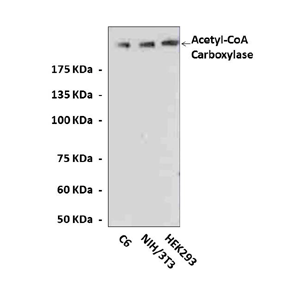Anti-ACC1: Polyclonal Acetyl-CoA Carboxylase 1 Antibody |
 |
BACKGROUND Acetyl-CoA carboxylase (ACC) catalyzes the biotin-dependent carboxylation of acetyl-CoA to produce malonyl-CoA. This is the first and the committed step in the biosynthesis of long-chain fatty acids. The most important function of ACC is to provide the malonyl-CoA substrate for the biosynthesis of fatty acids. The activity of ACC can be controlled at the transcriptional level as well as by small molecule modulators and covalent modification.1 A second isoform of ACC, ACC2, is associated with the mitochondrial membrane and produces malonyl-CoA that regulates fatty acid oxidation by potently inhibiting the carnitine palmitoyltransferases (CPT-Is). Mice that are deficient in ACC2 have elevated fatty acid oxidation and reduced body fat content and body weight, despite consuming more food.2 Therefore, inhibitors against ACCs might be efficacious for the treatment of obesity and diabetes (metabolic syndrome). The activity of the enzyme is also controlled by reversible phosphorylation. The enzyme is inhibited if phosphorylated; the phosphorylation can result when the hormones glucagon or epinephrine bind to their receptors, but the main cause of phosphorylation is due to a rise in AMP levels when the energy status of the cell is low, leading to the activation of the AMPK.3
REFERENCES
1. Tong L: Cell. Mol. Life Sci. 62:1784-1803, 2005.
2. Choi CS et al.: Proc. Natl. Acad. Sci. USA, 104: 16480-16485, 2007.
3. Janovska A et al.: Mol. and Cell. Endocrinol. 284:1-10, 2008.
2. Choi CS et al.: Proc. Natl. Acad. Sci. USA, 104: 16480-16485, 2007.
3. Janovska A et al.: Mol. and Cell. Endocrinol. 284:1-10, 2008.
Products are for research use only. They are not intended for human, animal, or diagnostic applications.
Параметры
Cat.No.: | CC1041 |
Antigen: | Sequence near human Acetyl-CoA Carboxylase carboxyl terminal. |
Isotype: | Affinity Purified Rabbit IgG |
Species & predicted species cross- reactivity ( ): | Human, Mouse, Rat |
Applications & Suggested starting dilutions: | WB 1:1000 IP n/d IHC (Paraffin) n/d ICC n/d FACS n/d |
Predicted Molecular Weight of protein: | 280 kDa |
Specificity/Sensitivity: | Detects endogenous levels of both Acetyl-CoA Carboxylase isoform proteins in various cell lysates. |
Storage: | Store at 4° C for frequent use; at -20° C for at least one year. |
*Optimal working dilutions must be determined by end user.
Документы
Информация представлена исключительно в ознакомительных целях и ни при каких условиях не является публичной офертой








